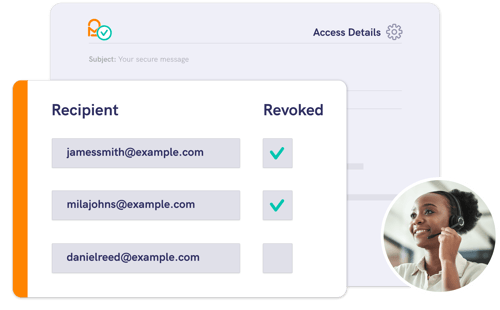Customer satisfaction is crucial, and protecting customer data, especially when communicating on an unsecured channel such as email, is essential for maintaining trust and building long-term customer relationships.
Here are 11 steps to follow to send secure customer emails and protect sensitive information from unauthorised or unintended access.
1. Deploy An Email Policy
Deploying an email policy is an effective way to ensure that employees are aligned with company aims and adhering to safety protocols.
The policy should outline essential responsibilities and regulations, helping staff to maintain appropriate activities, avoid potential pitfalls, and keep cybersecurity front of mind.
2. Don’t Use Public Wi-Fi
As the name suggests, public Wi-Fi is open for everyone to use, which, while convenient for working professionals wanting to access online services on the go, also offers a lucrative opportunity for cybercriminals.
Some public Wi-Fis may be fake hotspots, set up by hackers to imitate a genuine network and gain access to any data transferred.

Threat actors can also conduct man-in-the-middle attacks, placing themselves between you and the genuine Wi-Fi and digitally eavesdropping on any information you send. When sending personal data relating to your customers, always do so on a secured network.
3. Know Your Compliance
No matter what industry you’re in, there are regulations your business must uphold. GDPR is just one example of this, requiring businesses to ensure the privacy of their customers' personal information.
As you can imagine, this holds particular importance when it comes to customer emails. Staying on top of regulations will ensure your company provides the best protection for customer comms.
If you're working in the financial services, you can check out our dedicated financial services email compliance checklist.
Or, you can use a solution that gives you compliance with UK regulations out-of-the-box (take a look at the best secure email services).
4. Avoid Personal Devices
With the pandemic introducing a rise in remote working, bring your own device (BYOD) practices have also increased.
This has significant risks attached to it, as staff are likely to use these devices for personal activities outside of working hours, potentially exposing themselves to hazardous bots such as malware.

Personal equipment is also likely to have less stringent security in place, providing an easier target for threat actors.
Studies have revealed that 30% of organisations have issued no protection against malware for their employee’s devices.
If possible, have employees use company-issued equipment. If BYOD is unavoidable, ensure staff install appropriate protection software before sending or opening customer emails.
5. Use A Strong Password
Did you know the most commonly used password is ‘123456’? Other popular contenders include ‘qwerty’ and ‘password’, and, while easy to remember, they take less than one second for someone to crack.
If the password to your email account is weak, this offers an easy opportunity for cybercriminals, where they can exploit it to gain access to all the conversations you conduct with customers.
To counteract this, it is recommended that passwords should use a mixture of upper and lowercase letters, numbers, and special characters while refraining from using common or personal phrases.
One often-recommended method involves incorporating three random phrases into the password for extra security.
6. Prioritise Staff Wellbeing
Within high-pressure environments, staff burnout can be a common and unwanted occurrence.
Aside from being unpleasant for your employees to experience, burnout symptoms such as fatigue and stress can cause them to make more flawed decisions and mistakes.

A common example of this is sending an email or attachment to the wrong recipient. Ensuring your staff receive an appropriate work-life balance and managerial support can counteract the risk of burnout.
To read more on how employee wellbeing impacts cybersecurity, and how to counteract it, read our 'fighting fatigue' whitepaper.
7. Apply Authentication
Two-factor authentication (2FA) is another layer you can apply to your customer emails, requiring the recipient to prove their identity before accessing any email content.
There are various types of 2FA, including SMS and Q&A (Question and Answer). These ensure that only the intended recipient receives messages containing sensitive data and counteracts the risk of data breach associated with sending an email to the wrong person.
8. Invest In Encryption
Email encryption is the scrambling or disguising of the contents of your messages and attachments, ensuring any sensitive information is hidden from unauthorised third parties.
The Information Commissioner’s Office (ICO) states that encrypted communication channels should be used when transmitting personal data to protect against email interception and the high risk of data leaks.
While some email providers have a layer of built-in encryption, it is often not robust enough for businesses in highly regulated industries such as the financial services or legal.
Introducing purpose-built secure email software can give your customer communications an appropriate level of protection through encryption and recipient authentication.
9. Consider Email Revoke
Email recall is a convenient feature, available with some email providers, allowing users to ‘take back’ any emails sent in error and prevent the wrong person from seeing potential sensitive data.

However, current recall capabilities included within email providers such as Outlook are far from perfect, often requiring a strict set of rules to work. To implement revoke capabilities that can be used reliably, you will need to consider dedicated email security software.
10. Log Out Of Accounts
It’s important to remember that not all threats come from a digital source. Leaving your equipment unlocked and unattended can also be an open invitation to those with harmful intentions.
Ensuring you log out of your email accounts when not in use, and locking your computer or other devices when vacating the area can help prevent unwanted individuals from accessing your messages.
11. Train Employees
Digital equipment and software are only as good as the people using them. That is why training is an instrumental step in a company’s cybersecurity strategy, ensuring everyone within the company’s structure is aware of cyber risks and how to counteract them.
Regular training and awareness programs should be carried out, tailored to the organisation's needs.
Get Protected
Following these steps can significantly enhance the security of your customer emails. Remember, ongoing vigilance and staff training are crucial in today's evolving cybersecurity landscape.

References:
GDPR Guidance and Resources, Information Commissioner's Office
BYOD Statistics, Finances Online
Most Common Passwords List, NordPass
Three Random Words, National Cyber Security Centre
Reviewed By:
Sam Kendall, 05.06.24
Sabrina McClune, 05.06.24

 Sabrina McClune
Sabrina McClune
 Sabrina McClune
Sabrina McClune

